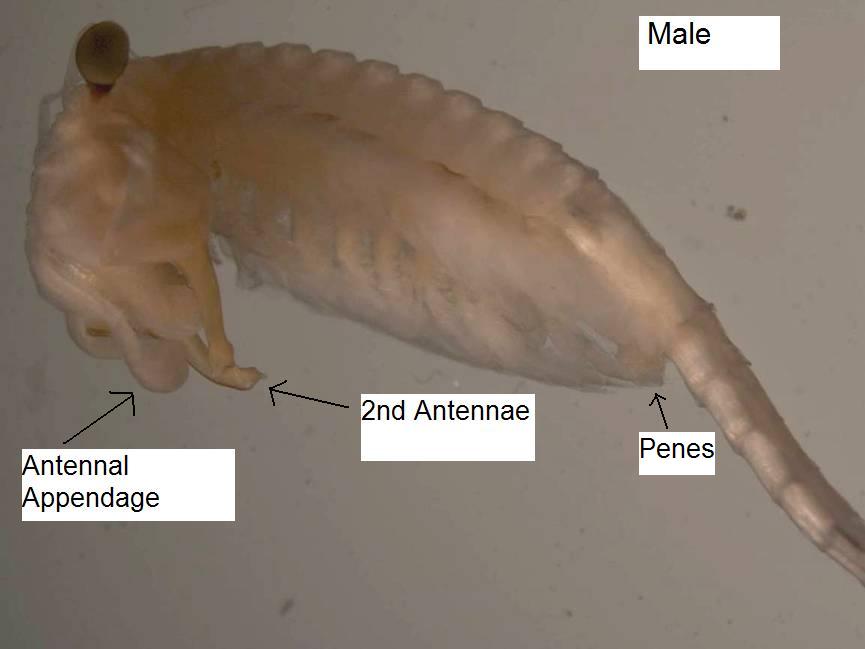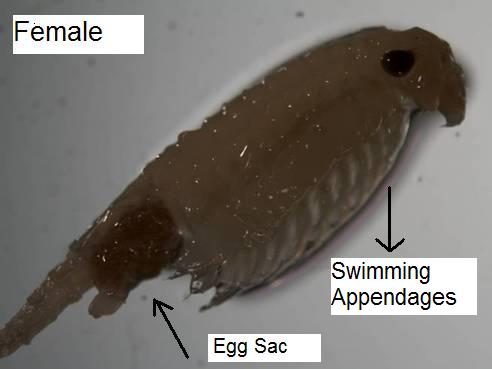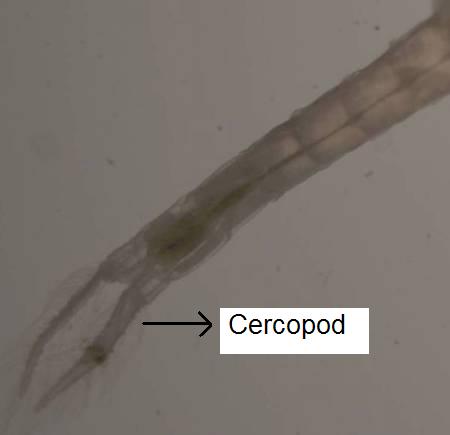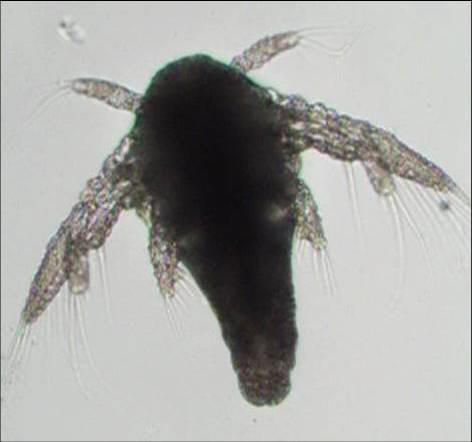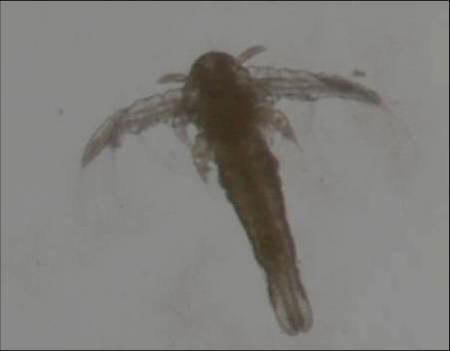 Zooplankton of the Great Lakes
Zooplankton of the Great Lakes
|
Chirocephalopsis bundyi Classification Kingdom - Animalia Taxonomic History The first identification of Chirocephalopsis bundyi
(fairy shrimp) was in 1876 by S.A. Forbes. In the past, this species
has been listed under the genera Eubranchipus
and Pristicephalus (Dexter 1953).
Anatomy Fairy shrimp are distinct members of the class
Branchiopoda with stalked compound eyes, 11 pairs of swimming appendages, and
a long, cylindrical body without a carapace (Ward and Whipple 1918).
These swimming appendages are used for locomotion, respiration, and food
consumption. Their total length usually ranges from 10 to 18 mm long (Pennak 1953). The coloration in fairy shrimp is variable, but is mostly a whitish color. The first
antennae of this species are relatively small, uniramous, and unsegmented (Pennak 1953). The body of a fairy shrimp is loosely
distinguished as the head and the trunk segments. The trunk segments includes the swimming legs, the genital segments, and the
telson with two cercopods (Figure 3). Female fairy shrimp have an elongated,
cylindrical second antennae, while the males have large second antennae
specialized for holding the females during copulation
(Pennak 1953). This male species of
fairy shrimp also has an antennal appendage, which
is ribbonlike and coiled close to the second antennae (Figure 1). The
genital segment includes the two penes on the male
and the egg sac on the female (Figures 1 and 2)(Pennak 1953). In addition
the females have a much more compact head and thinner body frame than the
male fairy shrimp. Distribution C. bundyi has been observed in various different localities, but is common in the northern states and
Canada. Some of these locations include Alaska, the Yukon Territory,
Alberta, Manitoba, Ontario, Quebec, Massachusetts, New York, Michigan,
Wisconsin, Ohio, Indiana, and Wyoming (Pennak
1953). The locations of these fairy shrimp are variable from year to
year in distribution and abundance due to favorable conditions (Ward and
Whipple 1918). In most locations, males are less abundant than females.
(Knight et al. 1975). These populations of fairy shrimp are more
abundant in the spring and then disappear in the summer with unfavorable
temperature conditions. C. bundyi is
rarely found in bodies of water that are warmer than 15 degrees Celsius. Habitat Fairy shrimp are
mostly found in temporary ponds or vernal pools. These bodies of water
are usually fishless because they are too temporary, small, and alkaline for
fish populations to survive (Pennak 1953).
Fairy shrimp are absent from lakes and are seldom
found in bodies of water that exceed one acre. These organisms would
not be able to survive with fish as predators, but can usually survive with
amphibians and carnivorous insects, which are other predators of the fairy
shrimp. Also, C. bundyi are restricted
to clear ponds or pools in opposition to other fairy shrimp, which inhabit
more muddy waters (Pennak 1953). Feeding Ecology The fairy shrimp primarily feed on algae,
bacteria, Protozoa, rotifers, and bits of detritus (Pennak
1953). This food is compacted in the ventral groove on a mucilaginous
string located between the bases of the appendages. The available food
is constantly traveling forward to their mouth using the movement of their
appendages (Ward and Whipple 1918). Mastication of their food occurs
right outside the digestive tract in an opening formed by the overhanging
labrum (Pennak 1953). It is believed that
this species feeds continuously, but that not all of
the food is ingested (Pennak 1953). The
primary food for C. bundyi are microscopic organisms and detritus, which they feed on
at the bottom sediment with their ventral side pointed downward (Pennak 1953). Fairy shrimp
are normally found swimming gracefully on their backs with the swimming
appendages faced up toward the light. These organisms frequently rest
on their dorsal side at the bottom sediments (Ward and Whipple 1918). Life History Reproduction requires both the male and female
for C. bundyi since they are not
hermaphroditic. Testes and ovaries are located on either side of the
digestive tract and within the genital segment respectively for males and
females. The males begin by taking a dorsal position to the female with
their second antennae clutched onto the females
genital segment (Pennak 1953). The male will
turn its body at a particular angle to the female so that it can curve its
posterior end and join its genital segment with the external uterine chamber
of the female (Pennak 1953). The process of
copulation only takes a few seconds or minutes, but the pair may stay
together for days before separating. The female carries its eggs in an oval brood
sac for one to several days before being released into the water. The
eggs are released in separate clutches (1-6 total) with anywhere from 10 to
250 eggs per clutch (Pennak 1953). Some of
these eggs become resting eggs as they dry out or are frozen until conditions
are appropriate to hatch. The resting period usually lasts about six to
ten months under normal conditions (Pennak 1953). The eggs of fairy shrimp hatch into a naupliar
stage with three pairs of appendages, which will become the first antennae,
second antennae, and mandibles in the adults (Pennak
1953). These nauplii will go through a series of instars where they
will shed their exoskeleton in order to grow.
Throughout these instars, the appendages will increase in number, size, and
complexity (Pennak 1953). At the sixth
instar, all the appendages are present, but it is not until the sixteenth
instar that sexual maturity is achieved (Pennak
1953). Instars for the genus Artemia can be observed in Figures
3, 4, and 5 respectively at days one, three, and five after hatching. Artemia
are from the same order as fairy shrimp and show many similarities in
their physical appearance as nauplii. Literature Cited Dexter, R.W. 1953. Studies on
North American fairy shrimps with the description of two new species.
The American Midland Naturalist 49(3):751-771. Knight, A.W., R.L. Lippson,
and M.A. Simmons. 1975. The effect of temperature on the oxygen
consumption of two species of fairy shrimp. The American Midland
Naturalist 94(1):236-240. Pennak, R.W. 1953. Fresh-water invertebrates of
the United States. The Ronald Press Company. 326-340. Ward, H.B. and G.C. Whipple. 1918.
Fresh-water Biology. John Wiley and Sons, Inc. 558-571. |
Figure 1. Male fairy shrimp
with distinguishing ribbon-like antennal appendages and small serrations on
the 2nd antennae. Figure 2. Female fairy shrimp
with a prominent egg sac, 11 pairs of swimming appendages, and a compact
head.
Figure 3. The forked tail or
telson with two cercopods and numerous long
filaments.
Figure 4. Day one
nauplius of Artemia.
Figure 5. Day three
nauplius of Artemia.
Figure 6. Day five
nauplius of Artemia. |
